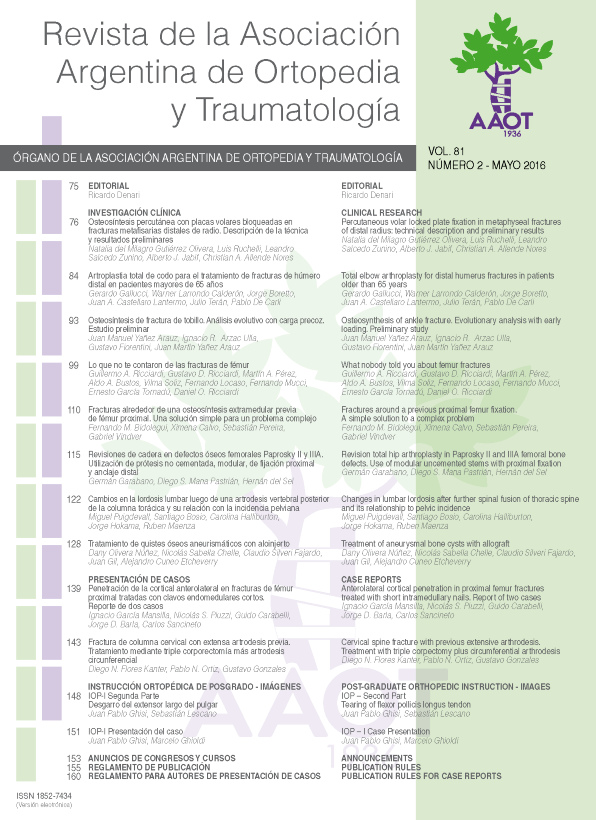Fractures around a previous fixation of proximal femur. A simple solution to a complex problem.
Main Article Content
Abstract
Downloads
Metrics
Article Details

This work is licensed under a Creative Commons Attribution-NonCommercial-ShareAlike 4.0 International License.
Manuscript acceptance by the Journal implies the simultaneous non-submission to any other journal or publishing house. The RAAOT is under the Licencia Creative Commnos Atribución-NoComercial-Compartir Obras Derivadas Igual 4.0 Internacional (CC-BY-NC.SA 4.0) (http://creativecommons.org/licences/by-nc-sa/4.0/deed.es). Articles can be shared, copied, distributed, modified, altered, transformed into a derivative work, executed and publicly communicated, provided a) the authors and the original publication (Journal, Publisher and URL) are mentioned, b) they are not used for commercial purposes, c) the same terms of the license are maintained.
In the event that the manuscript is approved for its next publication, the authors retain the copyright and will assign to the journal the rights of publication, edition, reproduction, distribution, exhibition and communication at a national and international level in the different databases. data, repositories and portals.
It is hereby stated that the mentioned manuscript has not been published and that it is not being printed in any other national or foreign journal.
The authors hereby accept the necessary modifications, suggested by the reviewers, in order to adapt the manuscript to the style and publication rules of this Journal.
References
2. Mosheiff R, Leibner ED, Safran O, Peyser A, Liebergall M. Retrograde nailing of femoral fractures distal to previous osteosynthesis. J Orthop Trauma 2000;14(5): 367-9
3. Frost SA, Nguyen ND, Center JR, Eisman JA, Nguyen TV. Excess mortality attributable to hip fracture: a relative survival analysis. Bone 2013; 56(1):23-9
4. Camporesi EM, Greeley WJ, Lumb PD, Watkins WD. Chapter 9 Anesthesia. En: Sabiston Jr DC, editor. Textbook of surgery. 14 ed. Filadelfia: WB Saunders Company; 1991. P. 148-63
5. Kellam JF, Aidigé L. Fracture classification. En: Rüedi TP, Buckley RE, Moran CG (eds). AO Principles of Fracture Management, 2nd ed. Stuttgart and New York: Georg Thieme Verlag; 2007:69-85.
6. Collins S, Moore RA, McQuay HJ. The visual analogue pain intensity scale: what is pain in millimeters? Pain 1997;72:95-7.
7. Krupp R, Malkani A, Goodin RA, Voor M. Optimal entry point for retrograde femoral nailing. J Trauma 2003 Feb;17(2):100-5
8. Martinet O, Cordey J, Harder Y, Maier A, Bühler M, Barraud GE. The epidemiology of fractures of the distal femur. Injury 2000;31(Suppl 3):62-3.
9. Lippuner K, Golder M, Greiner R. Epidemiology and direct medical costs of osteoporotic fractures in men and women in Switzerland. Osteoporos Int 2005;16(Suppl 2):S8-S17.
10. Rina J, Tornetta P III, Ritter C, Geller J. Neurologic and vascular structures at risk during anterior-posterior locking of retrograde femoral nails. J Orthop Trauma 1998;12:379-81.

